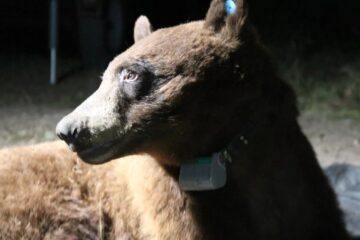Nonprofit group works to maintain SAMO programs
Many people use anticoagulant poisons to kill rodents and other unwanted creatures that come into their yards or homes in search of food and shelter. But they shouldn’t be so quick to act, says Julie Newsome, a Westlake Village resident, wildlife advocate and volunteer with the Santa Monica Mountains Fund.
Source of this article: The Thousand Oaks Acorn, February 28, 2013
Established in 1988, the fund was created by the National Park Service to support resource protection and educational programs within the Santa Monica Mountains National Recreation Area.
A Los Angeles native with an appreciation for the outdoors, animals, music and art, Newsome chairs the SAMO Wildlife Project Fund. The wildlife tracker and jazz vocalist was introduced to the nonprofit in 2008.
Last year she hosted a jazz benefit that raised $10,000 for mountain lion research. She also organized a wildlife education seminar in Westlake Village in conjunction with the National Park Service and California Wildlife Center. The intent of the seminar was to help people coexist with wildlife.
Arthur Eck, executive director for the SAMO Fund, said Newsome is a great activist for wildlife.
“She’s so passionate and works so very hard to help us raise money for both the mountain lion research program and the bobcat anticoagulant studies,” said Eck, who was superintendent of the Santa Monica Mountains National Recreation Area from 1995 to 2002.
In 2002, Eck became deputy regional director for the Pacific West Region of the National Park Service, representing almost 60 national parks throughout the western U.S. and the Pacific.
Rather than moving his family to Oakland, Calif., he chose to keep his home in Thousand Oaks because he was nearing retirement and wanted to stay near the Santa Monica Mountains.
“This park means a great deal to me and to the National Park Service, so I’m trying to do everything
I can to help it,” said Eck, who retired in 2004 and is now using his expertise for SAMO Fund programs.
In an era of tightened budgets, purchasing the necessary equipment to conduct research, such as GPS collars and remote wildlife cameras, is challenging. Raising money for the Santa Monica Mountains Fund is one way to ensure those needs are met.
“The national parks exist because of philanthropy,” Eck said.
Last year, SAMO Fund’s four volunteers raised $268,000 through grants and donations.
In addition to paying for research on wildcats, the money allowed the park service to buy a $6,600 radio collar with satellite access to track a mountain lion.
Funds also subsidized the publication of the quarterly Outdoor magazine and paid for a number of educational and restoration programs in the recreation area.
Fifteen percent of general donations to SAMO Fund are set aside to create a perpetual endowment for the park.
Species in the Santa Monicas are constrained by two freeways, an ocean and urban development. The impacts of cars, poisons and loss of habitat are causing animals and humans to lose the serenity of nature, Newsome said.
In a brochure titled “The Truth about Poisons,” Newsome offers tips to help people manage pests without resorting to harmful chemicals. For a copy, email wildlifepresentation@gmail.com.
Rodents serve an important purpose in the ecosystem as seed dispersers and as food for predators. Mountain lions ingest poison by preying on coyotes and other animals that have eaten poisoned rodents. Several lions have died in recent years due to anticoagulants used in rat poison.
For information visit www.samofund.org.



0 Comments